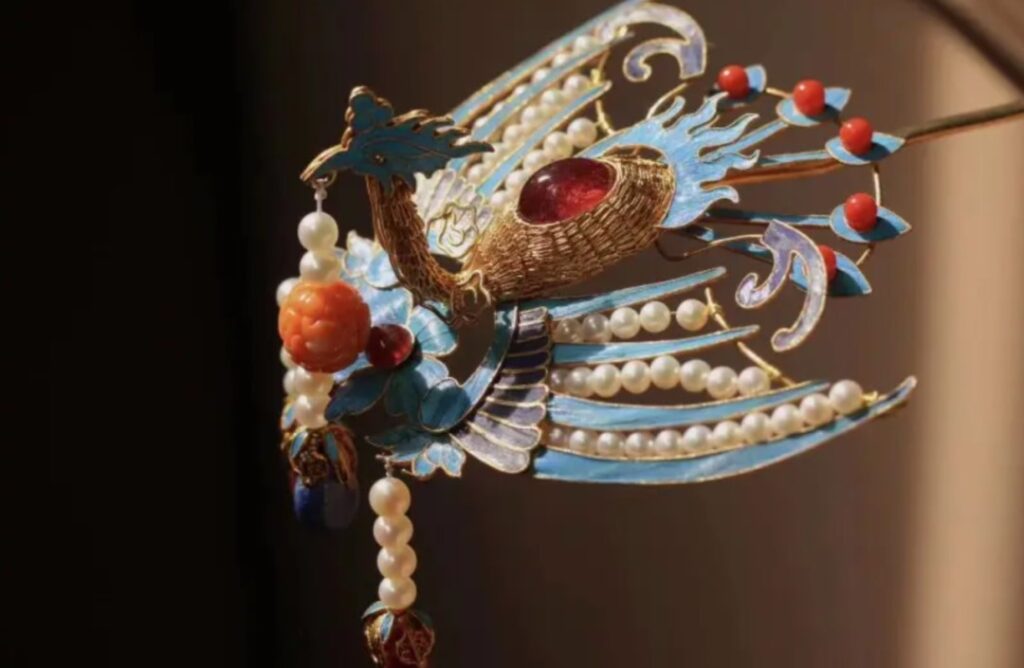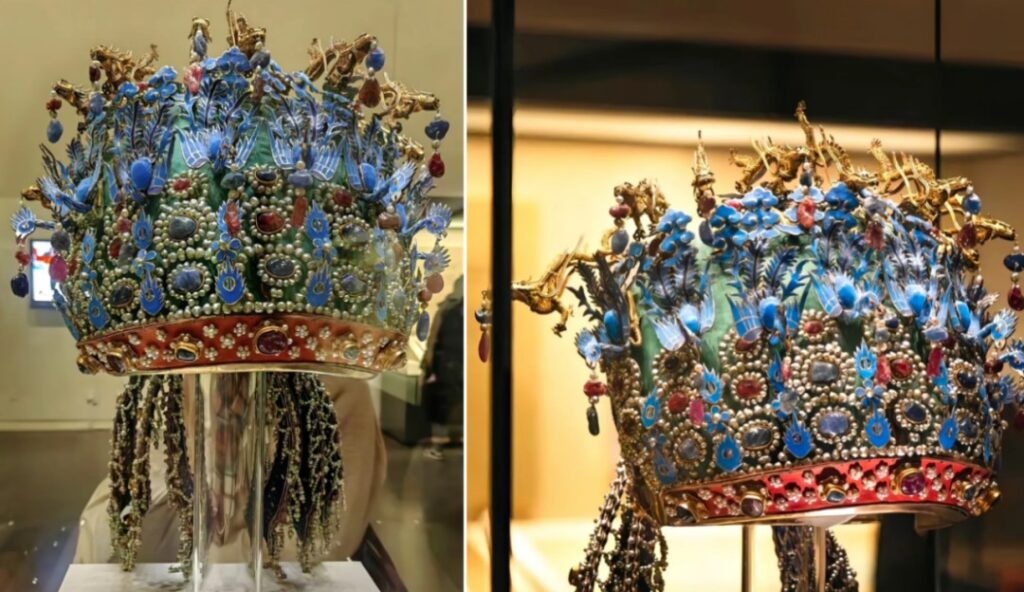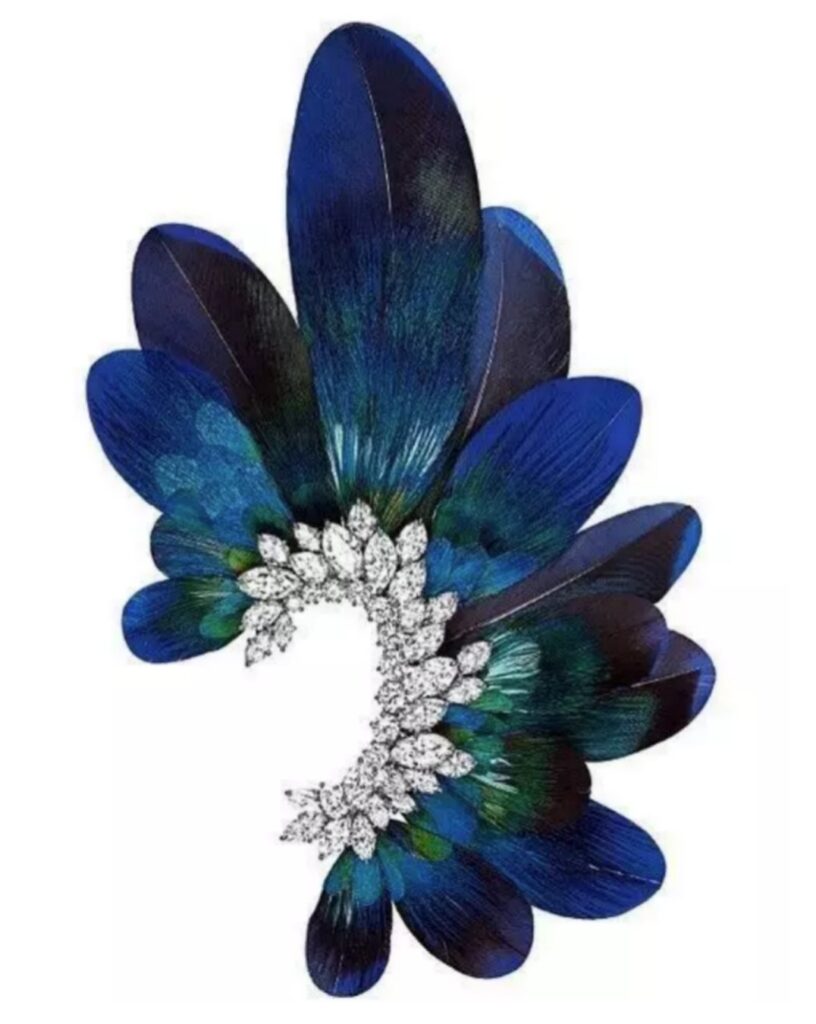
Diancui, or kingfisher feather inlay, is a traditional Chinese craftsmanship technique that uniquely combines the spirit of living creatures with the beauty of objects in jewelry making. With gold filigree as the base and kingfisher feathers as the soul, the unforgettable azure hue captivates the beholder.

The process of creating Diancui is incredibly complex, relying on the feathers of kingfishers. These feathers display various shades under different lighting conditions, including moonlight white, lake blue, and deep navy. The most prized colors are turquoise blue and snow-cyan.
Artisans manipulate the overall color presentation through intricate techniques such as underlaying colors beneath the feathers, adjusting feather density, aligning feather vein directions, and harmonizing textures with contours.
Combined with the natural patterns and iridescence of the feathers, these techniques create a dynamic, vivid, and exquisite artistic effect. This has led to the saying, “Gold by day, kingfisher by night.”

However, this stunning art form comes at a cruel cost. Kingfishers must be caught alive, as their mesmerizing luster fades immediately upon death, greatly diminishing the aesthetic value. Consequently, many describe Diancui as “cruel beauty.”
I. The History of Diancui Craftsmanship
Diancui as a jewelry-making technique can be traced back to the Warring States period. Historical records show that Diancui jewelry was already popular during the Tang Dynasty. Since ancient times, emperors’ dragon robes and empresses’ phoenix crowns have incorporated kingfisher feathers as crucial decorative elements, maintaining their brilliance through the ages.
This traditional gold and silver jewelry-making technique has a long history in China, with craftsmanship continuously improving and reaching its peak during the Qianlong era.
The most iconic examples are the “Four Phoenix Crowns,” the only ones remaining in China. These exquisite and luxurious crowns are listed as first-batch cultural relics prohibited from being exhibited abroad. One such crown was unearthed on October 20, 1957, in the underground palace of the Dingling Tomb, part of the Ming Thirteen Mausoleums in Beijing.

However, the extensive hunting of kingfishers during the Qing Dynasty gradually reduced their numbers. The reckless hunting for profit during the Republic of China era brought these beautiful creatures to the brink of extinction. The year 1933 marked a turning point; before then, Diancui jewelry was abundant in civilian circulation, but after 1933, these pieces seemed to vanish overnight.

II. The Creation Process of Diancui
The Diancui technique begins with crafting a base of gold or silver sheets shaped according to the design. Gold wire is then soldered along the edges of the pattern to create raised grooves. The recessed middle section is coated with an appropriate adhesive. Kingfisher feathers are carefully cut to match the base’s shape using small scissors.
The feathers are then delicately arranged using tweezers onto the adhesive-coated base, forming intricate auspicious patterns. Finally, pearls, jade, and other precious stones are inlaid, achieving a perfect fusion of precious metals and feathers.

III. Modern Inheritance of Diancui
In modern times, this traditional craft requires innovation. Firstly, in terms of materials, there’s a need to find environmentally friendly and sustainable alternatives, such as synthetic feathers or dyed silk threads, which can be twisted together to mimic the luster and color of kingfisher feathers.

Secondly, designs need simplification, reducing complex decorations and patterns. Styles should also be updated; the hairpins and crowns prevalent in ancient Diancui works should be redesigned into brooches, hair clips, earrings, watches, rings, and necklaces to suit modern wearing habits.
This creates simple and elegant pieces suitable for everyday modern life. Many brands have also applied this traditional craft to high-end wristwatches, using “feather inlay” on watch dials, considered an evolved version of Diancui.



Collaboration with other art forms can integrate Diancui with modern artistic elements, such as gaming or the metaverse, or apply it to modern daily objects, creating unique cross-boundary works. Finally, digital technologies like Virtual Reality (VR) or Augmented Reality (AR) can be utilized to allow consumers to experience the beauty of Diancui without damaging physical objects, enhancing its traditional appeal.


In essence, the art of Diancui lies in the “inlay” rather than the “kingfisher.” As an intangible cultural heritage of China, Diancui needs to continue appearing in the public eye in better forms, rather than silently residing in museums.
The Timeless Allure of Diancui Jewelry: A Millennium of Kingfisher Feather Art
Tweet





